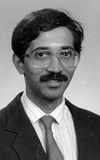Transplant docs to study minority organ donation
by Chris WestPublic Relations
The MUSC Transplant Center now has more than a million new ways to combat racial disparities in organ donation thanks to a new study funded by the National Institutes of Health.
 Dr.
Prabhakar Baliga
Dr.
Prabhakar Baliga
“The goal of the study is to address organ shortage,” said Prabhakar
Baliga, M.D., head of transplant surgery and principal investigator of
the project. “The number of patients waiting for healthy organs continues
to grow.”
Specifically, the five-year, $1 million grant will fund research, education and strategies aimed at correcting disparities among live organ donation within the African-American community. To date, it is the largest grant given to the MUSC Transplant Center.
“The grant is exploring educational strategies, we already know that a disparity exists,” Baliga said. “What we want to focus on now is creating strategies to overcome that disparity.”
The disparity Baliga describes is the disproportionate number of blacks on the transplant waiting list. Of the more than 600 patients waiting for kidney donation in South Carolina, 80 percent are African-Americans. And after applying the national average to South Carolina, only 15 percent of live organs are donated by African-Americans. It is estimated that more than a quarter of the waiting patients will never receive their much-needed organs.
And according to Baliga, much of the African-Americans’ unwillingness to participate in donation, especially live donation is fueled by suspicion and a lack of access to resources that would educate the population on donorship.
“People are scared of live donation,” he said. “People ask themselves ‘How do I live with just one kidney?’ when medically those people are very safe. Healthy people can donate a kidney and remain that way.”
Live organ donation of kidneys has been performed in the United States since the 1950s and boasts a higher success rate and quality of organ as opposed to cadaveric organs. Since most donated kidneys are given by a close relative, there is a better match and less chance of rejection. Through live donorship, the transplant can be scheduled ahead of time, which is not possible in the event of cadaveric kidneys. And finally, live donated kidneys begin to function immediately after transplantation, while cadaveric kidneys may take several days to weeks to begin functioning properly.
The problem with the positive information associated with live donation is that it isn’t widely known amongst minority populations. This will prove to be step one in the project for Baliga and co-investigator Kenneth Chavin, M.D., Ph.D.
 Dr.
Kenneth Chavin
Dr.
Kenneth Chavin
“Groups of patients will be screened and entered into one of two groups; a control and an active intervention group and both will receive educational intervention regarding donation,” Chavin said. “The control group will be attended by a non-minority facilitator while the intervention group will be addressed by a minority facilitator. The final hopes of the group study will help determine if race does actively play a role in the biases toward donation.”
And while the transplant team will bear the brunt of the study, they won’t go at it alone.
“This is really a joint grant,” Baliga said. “We are paired with the S.C. Area Health Education Consortium, the Gift of Life Foundation, Minority Pee Dee Health and the National Kidney Foundation. As collaborators in the grant, they will provide community support and help in disseminating information regarding donation to the local African-American community.”
“Being a five-year grant, the effects of intervention won’t be known for a number of years,” Chavin said. “Ultimately we hope to gain a better understanding of biases among minorities regarding donation and identify potential donors while overcoming these biases. And for the patients on our waiting list through live donation one more cadaveric kidney becomes available through a trickle-down effect.”
Baliga echoed the high hopes for the study in saying, “We hope to have a significant impact on live donation, especially in the long term. And while our grant will strictly address live donation, one could hope that through education we may have a positive long-term impact on cadaveric donation as well.”
For information regarding organ donation visit the National Kidney Foundation
at http://www.kidney.org.